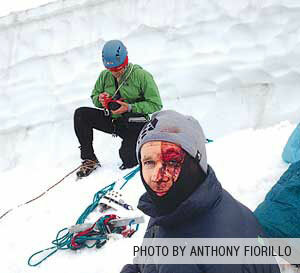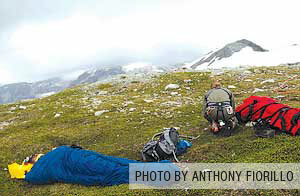Mountains beg to be climbed.
Their tall, unwavering peaks inspire dreams of conquering towering heights and call with siren-like attraction,  daring men and women to risk life and limb to make the summit.
daring men and women to risk life and limb to make the summit.
Glaciers only serve to increase the attraction – and the risk.
The North Cascades are no stranger to risk takers. With its wide swath of 684,000 acres stretching from the Canadian border into the heart of Washington, the mountain range is home to dozens of peaks and more than 300 glaciers. It’s the highest concentration of glacial fields in the lower 48 states and a playground for mountain enthusiasts.
When Jefferson Morriss, Keith LeMay and Anthony Fiorillo set out on September 8 to summit Ruth Mountain, a 7,115-foot peak in the North Cascades, they expected that it would be “an easy mountain,” a steady trip up and back and a great way to spend a weekend with the guys. What they didn’t expect is that they would find themselves 30 feet down in the intensely blue cavern of a crevasse and require Whatcom County Search and Rescue (SAR) to come to their aid.
The men left the trailhead on Saturday with the prospect of a clear, warm and sunny day, and made their way up through the alpine valleys to the glacial fields. By early evening, they had set up base camp on the saddle of the mountain. They spent the night there, with lightning storms in the distance behind the mountains. They had breakfast and broke camp before dawn on Sunday to make the final trek to the summit, arriving just in time for the sunrise. “It was gorgeous,” said Morriss, who took photos of the morning sky while the others rested. Then, around 10 a.m., they began to find their way back down the mountain.
On the way down, the climbers weren’t surprised to find a crevasse in their path. “We saw it a long way off,” Fiorillo said. “They’re all obvious.”
 “It was big enough for a car to drive into,” Morriss added.
“It was big enough for a car to drive into,” Morriss added.
The crack in the glacier posed an interesting scenario for the men. In general, it’s best to give these gaping fissures in the ice field a wide berth, just to ensure safety, but Fiorillo thought it might be a great opportunity to brush up on the crevasse rescue skills he had acquired in mountaineering school. After all, they were already roped in for ice climbing, he was confident in his training, and they had all the necessary gear on hand. It seemed like a good plan.
LeMay and Morriss agreed. “He asked me if I wanted to get some training and some pictures,” Morriss said. “I wasn’t going to pass that opportunity up.”
They laid pickets into the hard-packed snow, set up their protection like Fiorillo had learned in school and clipped in before they began to lower Morriss into the crevasse. He was barely over the edge when everything went wrong.
Before they could react, a picket broke free from its anchor point. Morriss’ weight pulled LeMay and Fiorillo forward, snapping them both through the air. All three were plunged deep into the cavern.
WHEN THINGS GO WRONG. Every year, thousands of people make their way into the North Cascades to play. Hikers, skiers, mountaineers – they go to find adventure and respite from their day-to-day lives, and most have a safe and happy trip, returning home relaxed and rejuvenated.
![]() But it’s not uncommon for things to go awry. Inclement weather sets in fast on the mountain. People get lost. Boulders fall while you’re taking a bathroom break. It all happens. “Anytime you’re in the backcountry, there’s the potential for danger,” said Ed Heincoop, Whatcom County Search and Rescue spokesman. And, when the worst does happen, that’s when SAR gets called in.
But it’s not uncommon for things to go awry. Inclement weather sets in fast on the mountain. People get lost. Boulders fall while you’re taking a bathroom break. It all happens. “Anytime you’re in the backcountry, there’s the potential for danger,” said Ed Heincoop, Whatcom County Search and Rescue spokesman. And, when the worst does happen, that’s when SAR gets called in.
The group responds to everything from bee stings to lost hikers to plane crashes. In his 17 years as a volunteer, Heincoop has seen it all. He has story after story of things going wrong in the backcountry, even when everything is done right.
Housed under the umbrella of Whatcom County Search and Rescue Council, the network is comprised of six groups: Summit to Sound, RACES Emergency Communication, Mountain Rescue, Whatcom County 4x4, Whatcom County Dive Rescue and Civil Air Patrol. The 200-member group, which is 100 percent volunteer based, is headquartered just north of Bellingham, and works in conjunction with the Whatcom County Sheriff’s Office. It partners with park-contracted helicopters, the Navy base on Whidbey Island and Immigrations and Customs Enforcement (ICE) for helicopter service. “We are really lucky,” Heincoop said. “There are very few teams that have the resources we do.”
The teams receive specialty training for their divisions, and many SAR volunteers are cross-trained across disciplines. Members pay for their own equipment, fuel and training, and provide their services to the area free of charge. It’s a lot of money, Heincoop admits, but there are plenty of non-tangibles that keep them in the game. “We do it because it’s fun. It’s a rush. It’s a kick in the ass,” he said.
INSIDE THE CREVASSE. The 30-foot fall had knocked Morriss and his friends unconscious. But they were lucky. They had all been wearing helmets, and while LeMay suffered the worst of the injuries – a brain bleed, lacerated liver, seven broken ribs and a collapsed lung – Fiorillo was still mobile and able to make his way along the fissure to where the crevasse narrowed and shimmy up to the surface. Despite a broken collarbone, he then climbed back up the glacier, to find cell service, and called 911.
 When a call like Fiorillo’s comes in, dispatch directs it to the SAR deputy on duty, who decides which SAR services are best suited for the situation. Team leaders are notified, and they send out texts or voicemail notifications to members. “My phone is on 24/7,” Heincoop said.
When a call like Fiorillo’s comes in, dispatch directs it to the SAR deputy on duty, who decides which SAR services are best suited for the situation. Team leaders are notified, and they send out texts or voicemail notifications to members. “My phone is on 24/7,” Heincoop said.
Team members show up at headquarters and choose the equipment they think they’ll need for the situation. Once the trucks are loaded up, they head to the site and determine the best place to set up base camp. On the way, they go over the details they’ve been given and brainstorm ways to reach victims most efficiently.
Given the nature of their predicament, with Morriss and LeMay badly injured at the bottom of the crevasse, the sheriff’s deputy thought it best to call in Mountain Rescue for the save, since they would need to get on the glacier and would have the technical ice skills required to perform the rescue.
After a detailed look at the area and the nature of the men’s injuries, the Mountain Rescue team decided to request a helicopter since it would take hours for the ground team to make the ascent, and Morriss and LeMay wouldn’t be able to walk out. The location dictated that it would probably be the best option to get them out.
But, a phone call to longtime helicopter pilot Tony Reece revealed that even that plan wouldn’t work. Conditions weren’t favorable for the helicopter to lift off. “When we got the call, the weather was so bad we couldn’t get in there,” said Reece, who owns Hi Line Helicopters and has clocked 22,000 hours of flight time in his 31-year career. “There was no visibility and the fog was moving in and out. It was too dangerous.” They decided the men would just have to wait it out until the clouds cleared enough for the helicopter to get through.
Fiorillo lowered hats, sleeping bags, food and gloves down to his friends to keep them warm through the wait. Eventually, things began to work in their favor. A group of climbers making a late descent helped pull Morriss and LeMay to safety and stabilized them, speeding up the rescue immensely. A break in the clouds gave Reece the opportunity he needed to fly in, hover with the toes of his skids on the ice and drop in a park ranger. “It helped so much and made it so much quicker,” Reece said. “I thought it was incredible that they took it upon themselves to pull the guys out of that crevasse.”
Two short-haul flights to waiting medivacs finally saw the trio off the mountain and to the hospital to receive treatment for their injuries. The group from Mountain Rescue that had begun the ascent to assist with the rescue continued onward to retrieve the men’s gear that had been left behind at the crevasse. Another brought Fiorillo’s car home for him with the recovered packs.
“It couldn’t have gone any smoother,” Fiorillo said later. “I’ve seen SAR at work in Colorado, and they do a good job, but I don’t think I’ve ever experienced anything to the extent of what they did here. It was very seamless.”
In addition to LeMay’s injuries, which left him in the ICU for several days, and Fiorillo’s collarbone, Morriss suffered lacerations to his face and a fractured ankle that had to be repaired with surgery.
FUTURE PLANS. Will they climb again? The reaction is mixed. “I think I’ll climb again in the future, and maybe somewhere down the line I’ll look at a crevasse again,” LeMay said. “But I don’t know.”
Fiorillo was more optimistic. “If you love something like climbing, not much will stop you,” he said.
Morriss was unsure. “Would I go climbing again? Yes. Would I would go willingly into a crevasse? I don’t know.”
Heincoop stresses the importance of calling 911 when faced with an emergency or when someone is missing. “Our phone isn’t manned. If you leave a message at our headquarters, it may not get heard for a week or two,” he said.
Calling 911 will put you in touch with the sheriff’s office, which will then determine whether SAR should get involved, and set any needed rescue mission into motion.
Interested in being a part of SAR? Heincoop says volunteers are welcome, and all it takes is showing some interest, attending a few meetings and being willing to learn. For more information, visit wcsar.org. X